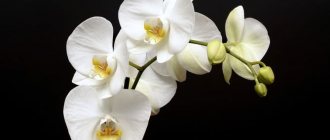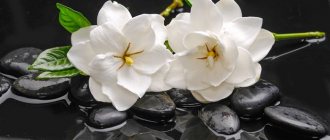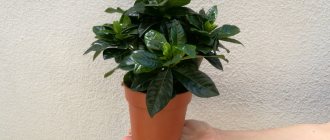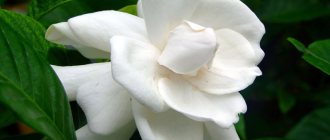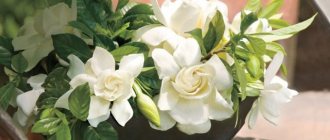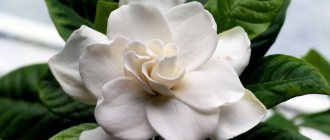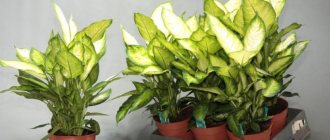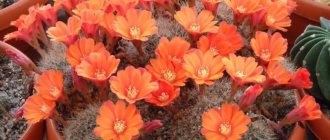Description of the plant
In the Madder family there is a genus of small shrubs or trees called gardenia, numbering about 250 species. The plant is found in tropical and subtropical regions of Southeast Asia, Africa, Australia and Oceania.
Gardenia received its name thanks to the famous botanists and taxonomists Carl Linnaeus and John Ellis, who named this evergreen shrub in honor of the American naturalist and physician Alexander Garden. And people began to call the culture “the bridal bouquet” for its beautiful snow-white flowers.
In nature, gardenias are evergreen trees or shrubs ranging in height from one to six meters. The glossy leaf blades are dark green and oval in shape with a slightly pointed tip.
Gardenia is a spectacular shrub covered with fragrant flowers
Gardenia buds are colored white, cream or yellowish. The corolla consists of several petals, the number of which is 5–12 pieces. The flowers are usually solitary, but in some species they are collected in small inflorescences. After the end of the flowering period, which usually occurs in spring and summer, a fleshy multi-seeded elongated fruit is formed on the plant (but this only occurs under natural conditions).
As befits a beauty, gardenia is very capricious and demanding of living conditions. Even with the slightest mistakes in care, it drops buds or refuses to bloom. Gardenia is very thermophilic and requires good lighting and soil rich in organic nutrients. Subject to the conditions of maintenance and rules of care, this beauty with an obstinate character will bloom annually, filling the house with a subtle and very pleasant aroma.
Gardenia is not only an amazingly beautiful plant that serves as an elegant interior decoration. The flower is an excellent medicine. For example, in China, gardenia is used to treat the upper respiratory tract; infusions from its flowers are taken to treat fatigue and insomnia.
Gardenia and tabernemontana
Very often gardenia is confused with tabernemontana. Externally, the plants are indeed a little similar, but still there is a significant difference between them. Tabernemontana has a milky sap in its shoots, which is characteristic of plants from the Kutrovaceae family. A distinctive feature of gardenia is the presence of stipules.
Despite their external similarities, tabernemontana and gardenia have significant distinctive features.
Varieties and varieties of gardenia for home cultivation (jasmine, brilliant, tree, etc.)
- Gardenia jasminoides (jasmine, jasminoides). The shrub is native to Japan, the Ryukyu Islands and China, and is also found in Africa. The flowers of gardenia jasmine are large, double, with delicate snow-white petals. The size of the leaf blades is 8 cm in length, their surface is shiny, the color is dark green. Varieties of this particular species or hybrids created on its basis can most often be found in the collections of flower growers. Among them are: First Love with double flowers painted in a cream tone, Flore Pleno with double double buds, Kleim's Hardy, whose distinctive feature is small waxy flowers and a compact bush shape, Veitchii, whose flowering lasts until December.
- Gardenia Tahitian (Tiare). This species got its name from the island of Tahiti, although its homeland is considered to be the Cook Islands and Hawaii. This is a rather tall spreading shrub, reaching four meters in height. It has beautiful dark green glossy leaves and creamy white flowers that exude an intoxicating aroma.
- Gardenia is brilliant. A distinctive feature of the species is the strongly corrugated dark green leaves with a shiny surface. The star-shaped flowers exude a sweet aroma reminiscent of apple and caramel, which is strongest at night. Gardenia brilliant is the most resistant to some diseases and pests to which all plants of the genus are susceptible. Thanks to this quality, it is very attractive for growing indoors.
- Gardenia rough. Under natural conditions, the shrub grows in North Queensland (Australia). It is a low tree growing up to 5 meters in height with snow-white flowers consisting of six petals. A characteristic feature of rough gardenia is year-round flowering.
- Gardenia tubifera. Homeland - Southeast Asia. This is a large shrub with a rounded crown. Large buds, emitting a strong aroma, change their color from ivory to golden yellow and orange. Flowering of Gardenia tubenosum begins in the spring and lasts until the end of summer.
- Gardenia keeled. A small tree native to Indonesia. Large buds up to 4.5 cm in diameter open white and then turn orange. On one plant you can simultaneously see snow-white, yellow, and orange flowers, making the bush look very impressive. Unlike other species, the aroma of Gardenia keelata is not very strong.
- Tree gardenia. The plant can grow up to 1 m. It has a spreading crown. Suitable for growing in the garden. Blooms from June to September.
- Gardenia thai (Gjellerupa). The species is very rare. White flowers bloom on the shrub, which subsequently turn yellow, and before falling off they acquire an orange tone. The plant is more tolerant of alkaline substrates and is more resistant to cold weather.
Photo gallery: types of gardenia, their names and features
The flowers of gardenia jasmine are large, double, with delicate snow-white petals
Gardenia Tahitiana has beautiful dark green glossy leaves and creamy white flowers that exude an intoxicating aroma.
A distinctive feature of the brilliant gardenia is its highly corrugated dark green leaves with a shiny surface.
A characteristic feature of rough gardenia is year-round flowering.
Large buds, emitting a strong intoxicating aroma, change their color from ivory to golden yellow and orange.
At the same time you can see snow-white, yellow, and orange flowers on one plant, which makes it very impressive
Thai gardenia is a very rare plant
Kinds
Gardenia jasminoides / Gardenia jasminoides
Other names are Cape Jasmine or Gardenia Augusta. It lives in the forests of the tropical zone of Japan and China at an altitude of up to half a kilometer above sea level. An evergreen shrub, which in natural conditions grows up to 2 m in height, and in indoor conditions - up to a maximum of 80 cm. The shoots are bare and smooth. The leaves are dark green, pointed at the base (inverted egg shape), glossy; the edge is solid. Flowers are collected in corymbose inflorescences of three to five pieces or grow one at a time; the color is white, turning yellow over time; grow at the top of the shoots. The flowering period usually falls on July-October, but it varies. Read more about caring for gardenia jasmine.
Variety variegata
variegata variety has white and double flowers, and the leaves have yellowish spots.
Variety First Love
First Love variety has fragrant double flowers (up to 13 cm in diameter) of a creamy white color; It blooms from March until the end of summer, and may bloom a second time.
Variety Flore Pleno
Flore Pleno variety has large double double flowers.
Variety Fortuneana
Gardenia jasminoides Fortune (Gardenia jasminoides var. fortuniana) - double flowers are similar to camellia flowers, the diameter of which is 10 cm. Can be found as the Fortuneana variety.
Kleim's Hardy variety
Kleim's Hardy is small in size and has waxy flowers, blooming in spring and summer.
Variety Radicans
Gardenia jasminoides var. radicans has a pleasant scent and double flowers. Also referred to as the Radicans variety.
Variety Veitchii
Veitchii variety has double, double, fragrant flowers. The leaves are glossy and green. Blooms until the end of December.
Conditions for winter and summer (humidity, temperature, light)
Among gardeners, gardenia is considered a difficult crop to grow indoors. For excellent growth, development and flowering, it requires a number of conditions.
Table: conditions for different seasons
| Season | Lighting | Humidity | Content temperature |
| Spring Summer | Gardenia is a lover of bright light, but it must be protected from the scorching rays of the sun, otherwise the leaves may get burned. The best location option is windows facing west or southwest. | The flower requires high and uniform humidity. To ensure ideal conditions, it is recommended to install an electric humidifier near the gardenia. If this is not possible, then you can place the gardenia pot on a tray filled with wet pebbles, having previously isolated the drainage holes (the roots should not come into contact with water). | 21–24°C during the day, 15–18°C at night. For gardenia to bloom, the difference between day and night temperatures is important. |
| Autumn winter | The plant needs to be provided with the maximum possible bright light. To do this, the flower can be placed on the windowsill of a south window and illuminated with fluorescent lamps. | When kept cool, it is necessary to reduce air humidity. In winter, it is enough to give gardenia a warm shower once a week. | 16–18оС. During this period, gardenia lays flower buds. If the room is warmer, it will not bloom, and the shoots will grow thin and weak. |
Gardenia varieties suitable for growing indoors
Terry varieties of gardenia:
Aimee Yoshida, August Beauty, Billie Holiday, Chuck Hayes (semi-double), Fortuniana, Michael, Mystery, Crown Jewel, Heaven Scent (about 90-120 cm high, blooms exceptionally profusely), Jubilation (re-blooming, 90-120 cm high), Radicans (30-60cm tall), Radicans Variegata (cream-edged leaves, often reverts to the parent's normal green appearance), Veitchii (50-80cm tall).
young gardenia plant
Non-double gardenia varieties:
White Gem (one of the most popular non-double gardenias for growing in containers, at maturity - no higher than 60 cm), Daisy, Daruma, Grif's Select, Kleim's Hardy, Shooting Star.
How to properly maintain a plant at home
Proper care will ensure the health of the gardenia, as well as its abundant, long-lasting flowering.
How and with what to water
It is recommended to use warm, boiled and settled water for irrigation. In summer, watering should be plentiful, and in winter - moderate. Periodically, you can add a few drops of freshly squeezed lemon juice (1 teaspoon per 1 liter of water) or 1-2 crystals of citric acid to the water. This will help maintain the acidity of the soil that gardenia needs.
Top dressing
Gardenia blooms continuously for a long time, so it needs a large amount of nutrients, with a lack of which it drops its buds and develops chlorosis. Before flowering and during the period of active growth, once every two weeks you should feed the gardenia with a universal complex fertilizer for flowering plants, diluting the solution according to the instructions. Experienced flower growers recommend using Kemira Lux for the procedure.
Gardenia growth and flowering period
Gardenia begins to bloom in April. This period ends only at the end of summer, and for some hybrids it lasts all year round. However, both need to be given a little rest in the winter so that the plant gains strength and lays new flower buds.
Gardenia flowers are beautiful and fragrant
Care after flowering: what to do in the fall
In October, it is recommended to trim the gardenia by shortening all the branches and cutting out the shoots growing inward. After this, the flower must be placed in a cool but very bright place, and the amount of watering must be halved.
Wintering gardenia
Gardenias do not have a clearly defined dormant period, and some hybrids can bloom all year round. However, in winter the plant needs to have a period of relative rest when kept cool. A rested flower will bloom more profusely.
For a cool winter, place the gardenia on a south-facing window and provide it with additional lighting with fluorescent lamps for up to 12 hours a day. The temperature in winter should be around 16–18°C. This can be achieved by separating the flower from a warm room with a screen. During this period, stop feeding and reduce the amount and volume of watering by half.
In the fall, before wintering begins, gardenia must be pruned.
An important condition is that the roots of gardenia should always be in warm soil. If the window sill on which the gardenia stands is cold, then place a piece of foam under the tray, thereby saving the flower from hypothermia and rotting of the roots.
Video: proper plant maintenance
Table: causes of problems (leaves wither, darken, wither, turn yellow, dry out, fall off, etc.), their solution
| Problem | Probable Cause | How to fix the situation |
| The buds are falling |
|
|
| Gardenia doesn't bloom |
|
|
| The leaves are withering | lack of watering |
|
| Leaf blades turn yellow |
|
|
How to save a plant from diseases and pests
Gardenia is prone to various diseases; a capricious plant, with any violation of care, can develop chlorosis, carbon mold and other diseases.
Table: why diseases appear and how to revive a plant
| Diseases and pests | Signs | Reason for appearance | Treatment and prevention measures |
| Chlorosis | The leaves turn pale and yellow streaks appear on them. If chlorosis is not treated, the plant may die. | iron deficiency |
|
| Charcoal mold | The leaves begin to darken. Affected leaves may fall off. | lack of light and poor air circulation |
|
| Mealybug | White lumps similar to cotton wool appear on the leaves. | excessive dampness |
|
| Thrips | Grayish-white dots form on the leaf blades. | excessive dry air | Treat gardenia with insecticidal soap or Decis (according to instructions). |
| Shchitovka | Brown bumps and sticky discharge form on the leaf blades. The leaves become paler in color. | insufficient humidity in the room |
|
| Whitefly | Greenish larvae cover the underside of the leaves. Severely affected leaf blades turn yellow and fall off. | overwatering |
|
| Spider mite | The visible mark of the mite is a thin web on the plant. Insects suck the juice from the leaves. If measures are not taken in time, the leaves may wither, turn black and ultimately dry out. | the air is too dry |
|
Photo gallery: plant treatment for spider mites, whitefly, chlorosis
You can get rid of scale insects using a soap solution
The drugs Actellik or Decis will help defeat the whitefly.
The flower gets chlorosis due to hard water

